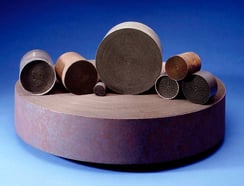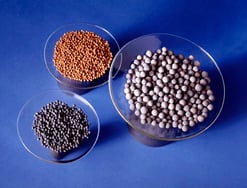There are hundreds of types of catalyst products at work in the world today. This series will focus only on the use of precious metal catalysts used in air pollution control systems. The most traditional air pollution control device that employs a precious metal catalyst is a Catalytic Oxidizer. Although catalysts have been used in Regenerative Thermal Oxidizers as a means to lower the operating temperature and reduce natural gas consumption, they can also be installed in a catalytic reactor or catalyst bed where the pollutants are found in a pre-heated exhaust stream.
Our engineering and service team have compiled an ebook that we hope can help operators of catalytic oxidizers and catalyst reactors achieve optimum performance. Some of the topics discussed in the ebook include:
Catalyst Basics and General Operating Guidelines
Catalyst performance depends on the original design criteria from the catalytic oxidizer manufacturer. Performance is dependent on catalyst volume, pressure, temperature, and the type and concentrations of volatile organic compounds (VOCs).
The performance of the catalyst is related to care in installation to ensure no by-pass or leakage of exhaust gases through the catalyst bed. It is also a function of even, uniform flow and temperature across the face of the catalyst bed. The performance of the catalyst will also depend on how well the catalyst is maintained during its operational life.
CATALYST TYPES:
 |
Ceramic Monoliths (sometimes called Honeycomb). These products will be installed in a stainless steel module and mounted in a fixed bed or grid. |
 |
Metal Monoliths (sometimes called Honeycomb). These products will be installed in a stainless steel module and mounted in a fixed bed or grid. |
 |
Ceramic beads or spheres. These products allow for pourability and are usually contained in a catalyst tray. |
TEMPERATURE:
The operating temperature range has been chosen in order to achieve the correct destruction efficiency. The catalyst functions within a specific temperature range. Below the minimum operating temperature, the catalyst will not operate and there will be no destruction of the VOCs. Above the maximum temperature, the catalyst is subject to thermal degradation, which will result in a shortened catalyst life.
PRESSURE DROP:
The presence of the catalyst in the exhaust stream will introduce back pressure or a pressure drop. The result is that more effort is needed to push the exhaust through the system than without the catalyst present. The back pressure induced is a function of the volume of exhaust gas, its temperature, the surface area cross section of the catalyst bed, and the depth of the catalyst. For example, a given exhaust flow at 600° F will have less pressure drop than the same exhaust flow at 800° F. Likewise, a given exhaust flow will have greater pressure drop across a catalyst bed of 12" than for 6".
SPACE VELOCITY:
Your catalyst has been designed for a certain specific space velocity in order to meet the required destruction efficiency of your application. This means that a given number of cubic feet of catalyst was determined for the application based on the exhaust flow rate, the type of solvents exhausted, their concentration, and destruction requirements.
FACE VELOCITY:
Face velocity refers to the speed of the gas traveling through the catalyst bed. The feet per minute (fpm) of air movement, as it is commonly referred to, is the speed of the gas. The measurement can be taken either hot or cold. The typical linear face velocity for VOC catalysts is between 400 and 650 fpm at standard conditions, i.e. 70° F.
LIFE CYCLE CURVE:
Catalyst activity does not typically drop off dramatically under normal circumstances. With annual catalyst testing, the life of a catalyst can be predicted with good accuracy. In some instances, the user will find a noticeable decrease in temperature rise, which can be directly proportional to a drop in the destruction efficiency. From experience, this often occurs between 30,000 and 50,000 operating hours, depending on a variety of factors. The catalyst life is dependent on the type of VOCs, the amount and type of inorganic masking agents present, the number of times cleaned, and operating temperature. Typical catalyst masking agents are silicon, phosphorous, and base metals such as iron, lead, nickel, chrome, tin and titanium.
Read the entire ebook Catalytic Oxidizer Design and Operations Basics for information on:
- Catalyst Inhibitors
- Analytical Services
- Removal and Installation Guidelines
If you working on an air pollution control project and have some questions, please contact us:









